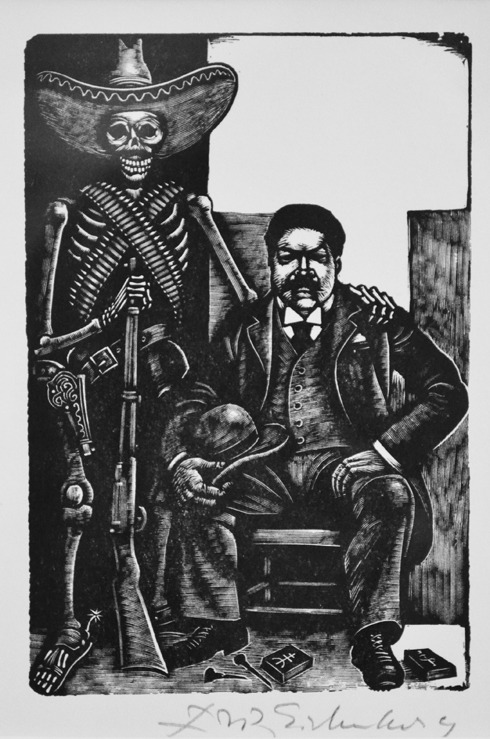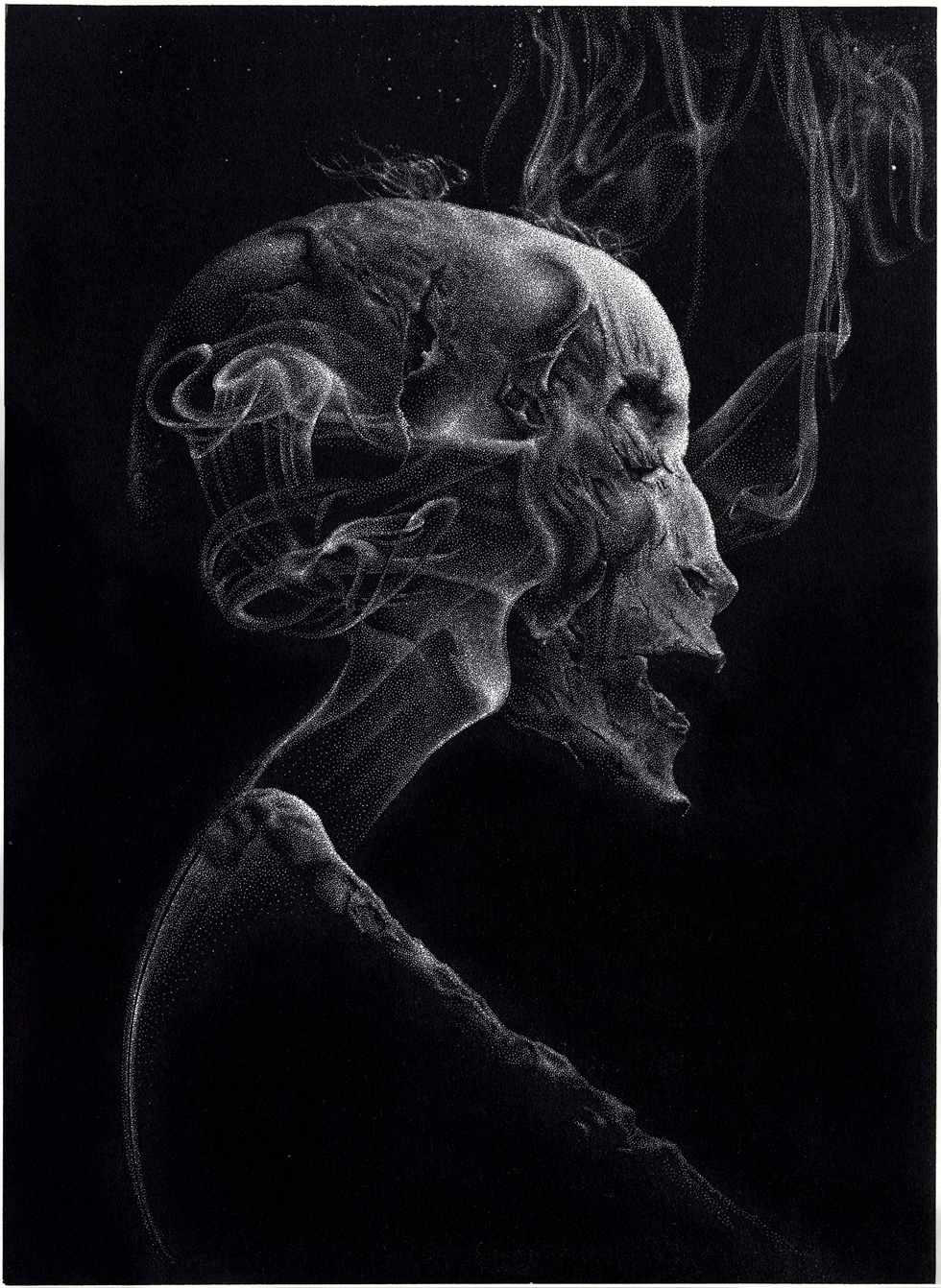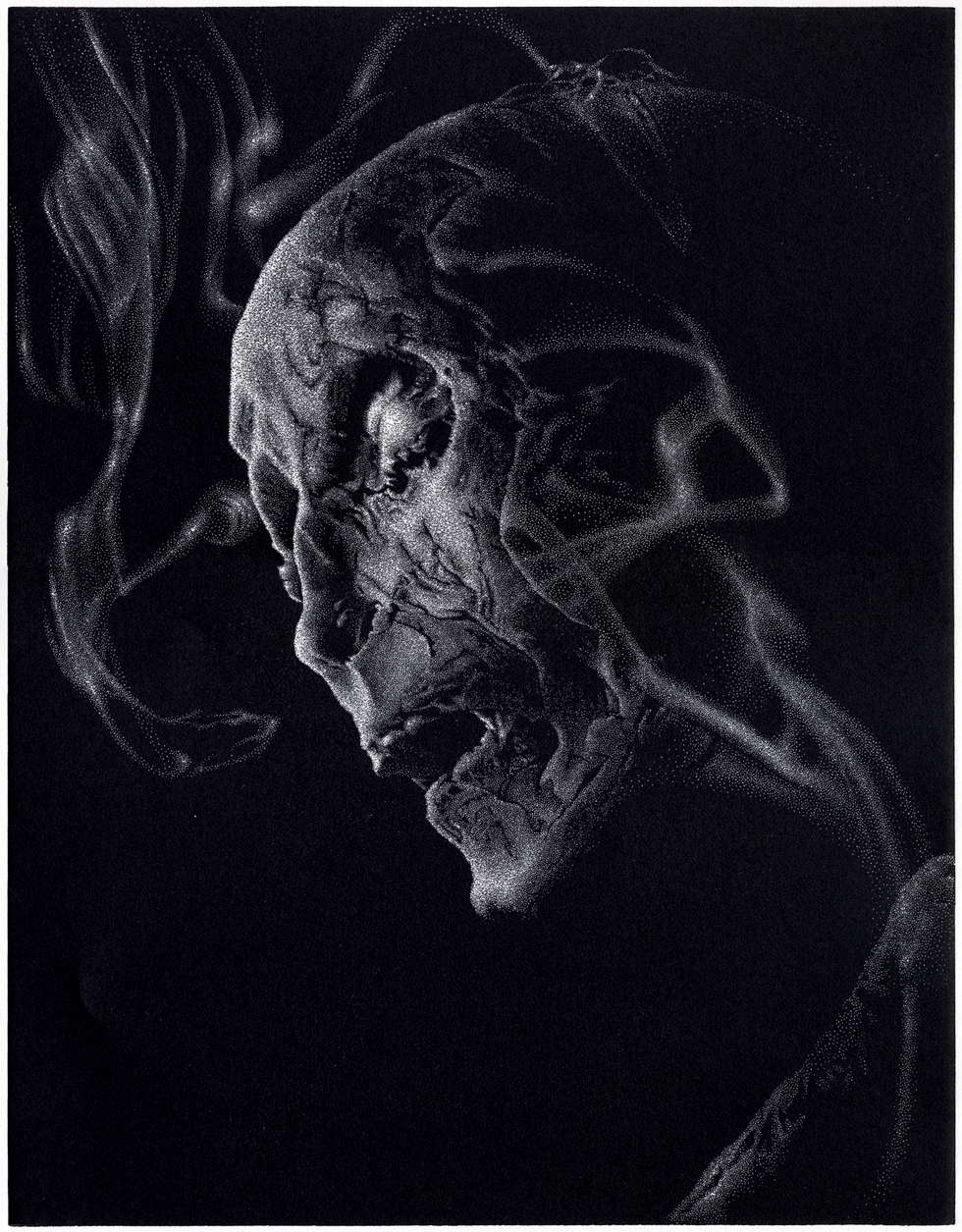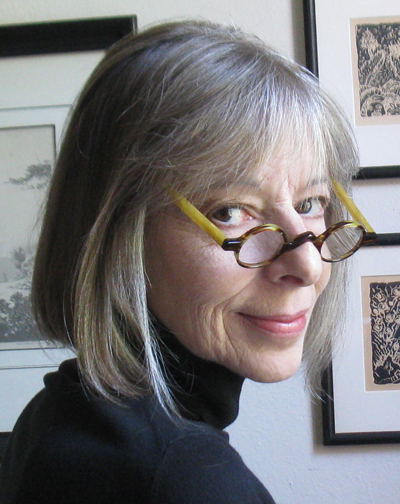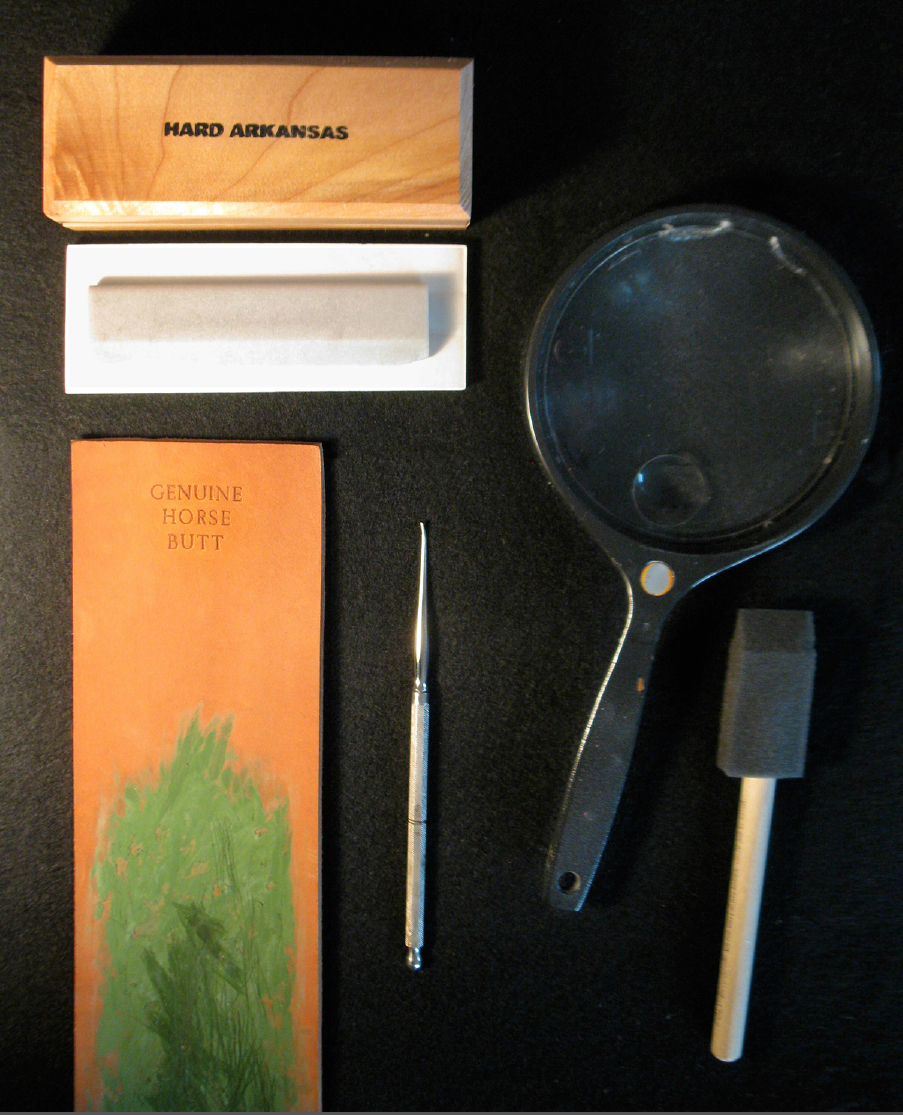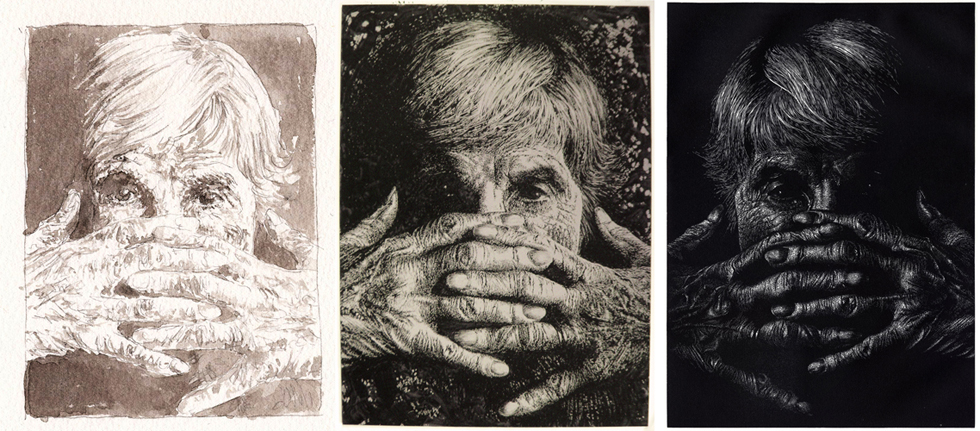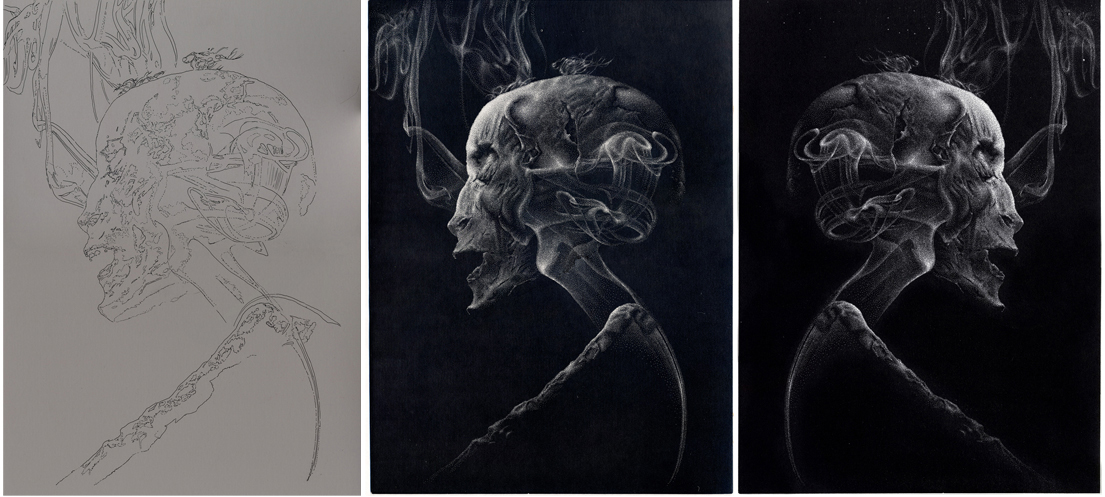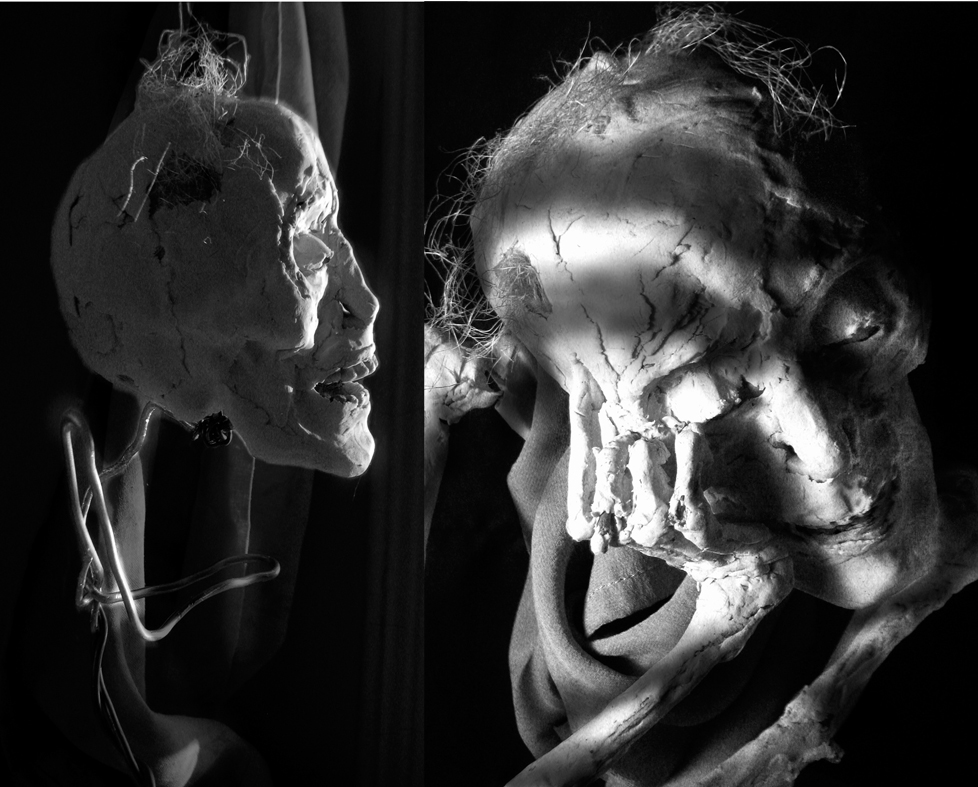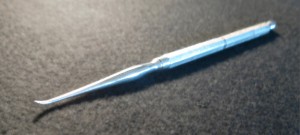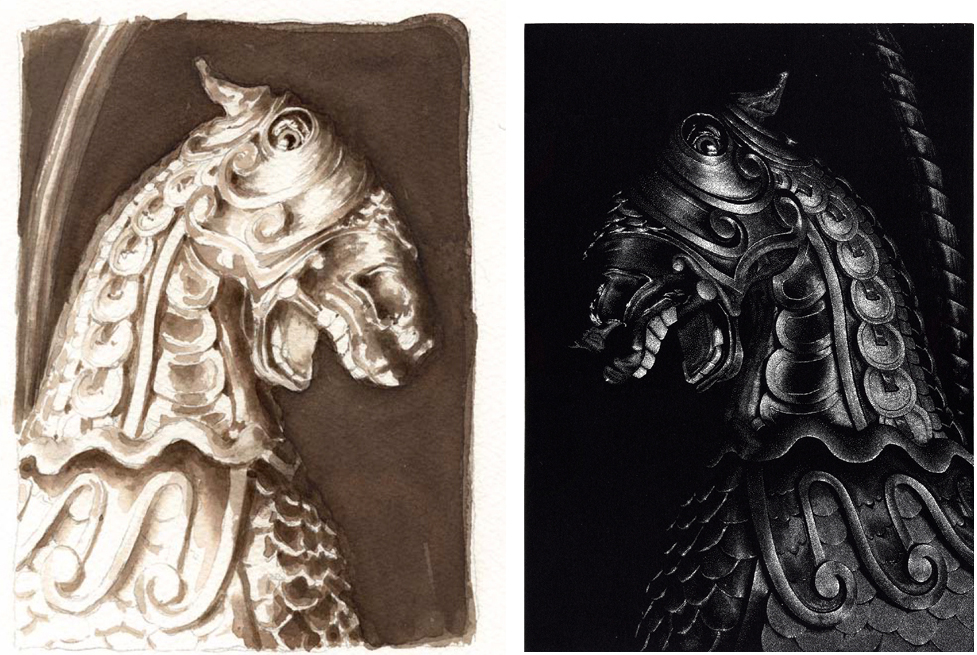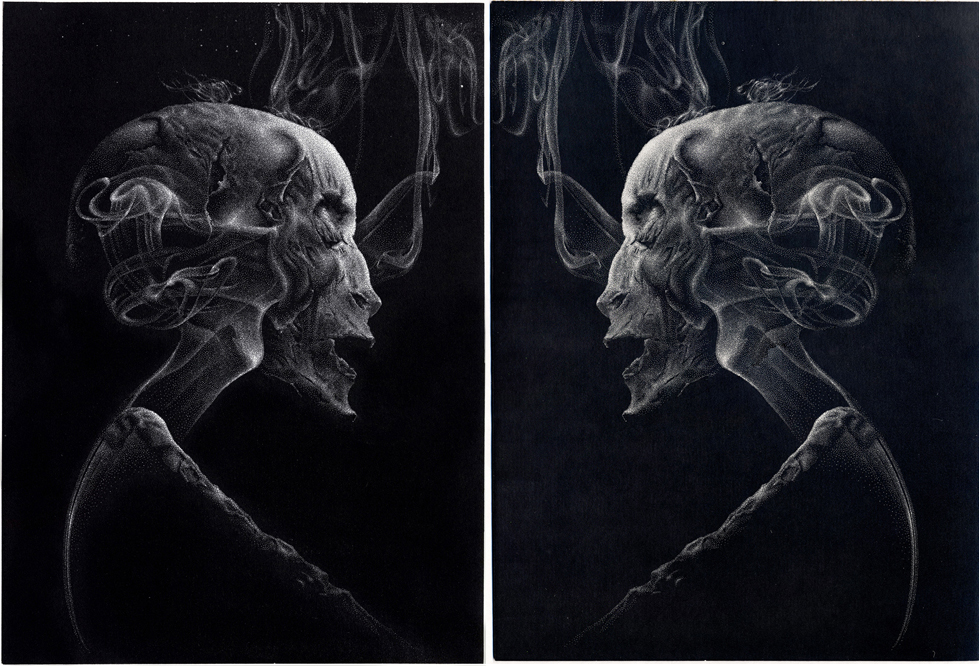DONNA DIAMOND: Imagining/Imaging Mortality Dot-by-Dot
INTRODUCTION
I try to follow a theme when I hang prints from my collection, for instance: industry and labor unrest in the front parlor; the noise, hardship and bustle of city life in the dining room; nudes in the bedroom; circus and carnival scenes in the guest room; and in my office–the holy of holies–death. The images there tend to be playful, not gruesome–although there’s a signed Gustave Doré-designed wood engraving of a corpse holding up his severed head before a stricken Dante (one of his illustrations for John Milton’s epic poem Paradise Lost). More typical is this wood engraving by Fritz Eichenberg entitled Posada, 1965, edition of 10. (According to the Childs Gallery website, the image was an “illustration for Posada’s Dance of Death by Jean Charlot,” Pratt Graphic Art Center, New York, 1964, edition of 500). Of course Pasada refers to José Guadalupe Posada (1852-1913), the great Mexican printmaker who often used calaveras–grinning skeletons–to get his socially barbed messages across.
Several years ago while perusing the Old Print Shop website, I came across a pair of startling images by Donna Diamond: Clay and Smoke I and II. Each linoleum cut, measuring 22″ x 16,” was pure magic. Ribbons of smoke danced around a mummifyed head shown in profile, a strong light playing off its withered eyelids and gaping mouth. The website allowed me to enlarge the images to about 6″ x 4,” but I still couldn’t see the seemingly minute white marks that made the image work so wonderfully against a velvety black background.
Well not every purchase is a spontaneous affair. A few years elapsed before I came “face to face” with Clay and Smoke I and II. In fact if it wasn’t for a losing bid on eBay for a small portfolio of very early Robbert Gibbing’s (British, 1889-1958) woodcuts, I might not now possess copies of Clay and Smoke I and II. After the loss last December, it dawned on me to contact Donna through her website: http://theartofdonnadiamond.com/index.asp As is my practice now when I first contact an artist about his/her work, I provided a link to my Art I See blog as a way of introducing myself as a serious collector. Once again it broke the ice, and we soon agreed on my purchasing both prints–I couldn’t decide which I liked better.
Her prints were indeed a great delight in person. I immediately wanted to know about what motivated Donna to make them and how she made them. Fortunately she was most gracious to agree to answer my questions and to supply me the all of the following images.
Clay and Smoke I, edition 20 (top), Clay and Smoke II (bottom), each 22″ x 16″, editions of 20.
INTERVIEW WITH DONNA DIAMOND
Who have been your mentors, sources of inspiration?
After graduating from college, I returned to NYC, and studied printmaking with Bob Blackburn at the Robert Blackburn Printmaking Workshop. Over the years he became a mentor and a friend. Bob was an extraordinary man. We had long conversations about art and life, and his sensibilities have been a tremendous influence on me throughout the years.
The only prints on your website are fully developed technique-wise. Can you take me back to the early days of your printmaking? What medium did you start with, when, where?
I have always loved to draw and, early on, I experienced printmaking as an extension of drawing. At the time, I focused on monotypes and I experimented with relief on copper and zinc. Bob Blackburn helped me choose a small press for my studio at home. However, when I had my daughter, I took a hiatus from printmaking because of the toxicity of the chemicals.
I returned to printmaking a few years ago, saw it anew, and became passionate about making prints. I rejoined the Robert Blackburn Printmaking Workshop–which had closed after Bob’s death and reopened under The Elizabeth Foundation–and began to explore printmaking possibilities. I was attracted to linoleum and wanted to find the shadowy light in the material.
The work on my website is the work I have done since. I feel as if I’m at the beginning of an adventure; so I think of the work on my website as my “early days” as a printmaker.
Your prints looks like they are composed with thousands of pin pricks. What technique did you use to create them?
My objective was to find the shadowy light in linoleum with my own personal marks. I found it very difficult to make my own marks with store-bought tools. At first, I tried to reshape the store-bought tools with stones and honing compound. Then I took broken dental picks and began shaping and honing them to make tools that would allow me to think fully in light and dark and make very personalized cuts.
Some of Dona’s tools for creating her linoleum cuts, including dental pick, Arkansas stone for sharpening and magnifying glass.
In a later email Donna mentions another inspiration for her use of small marks to compose her images:
I do admire the work and skill of Timothy Cole [American, 1852–1931]. I’m familiar with his work from my 1906 Century Magazine.
Cole was one of the most admired reproductive wood engravers in the late 19th century. I covered wood engravers of this period in three posts, beginning with: http://www.scottponemone.com/new-school-wood-engravers-forgotton-19th-century-celebrities/
Take me through step-by-step from an idea for an image, creating and perfecting a sketch, prepping the linoleum, transferring the sketch, and pricking the image, and proofing.
Before starting something new, I spend time looking at prints at the New York Public Library Print Collection. I also look at art in books in my own library as well as on the internet. [For instance] the series “What Dreams May Come” explored my concerns about aging and mortality, and was kindled by seeing four self portraits by Kathe Kollwitz at the New York Public Library.
Making linoleum prints, I quickly realized that I could make cuts, but I couldn’t put them back. So I plan my linoleum cuts carefully.
My prints begin with a lot of very rough pencil sketches. When a pencil sketch feels like it might work… I play with light and composition in a more detailed drawing. I often look at reference (created or gathered) to help resolve drawing issues. (Sometimes I scan my drawing and play with it in Photoshop) Then I transfer my drawing onto linoleum using a projection machine called an artograph. On my first few linoleum cuts (Ann in Winter), I rendered the entire image as an ink drawing on the linoleum. In subsequent prints, I began indicating the image on the linoleum with a kind of topographical line (Clay and Smoke). The next step is to glaze the linoleum with a translucent layer of black ink and let it dry. This lets me see my cuts more clearly.
I begin cutting marks very slowly. I cut marks following the light and I listen to a lot of J.S. Bach. The image changes and transforms as I’m cutting it.
The blocks I have been creating are too big for the press in my home studio, and so I’ve been printing on larger presses at the Robert Blackburn Printmaking Workshop with the artist/printer Justin Sanz. When my block “looks finished,” I meet with Justin at the Blackburn Workshop to make proofs and edition.
Three steps in the production of Donna’s linoleum cut Ann in Winter: (L to R) preliminary drawing, drawing on the block and finished print.
Three steps in the production of Donna’s linoleum cut Clay and Smoke I: (L to R) topographic line drawing, finished block and finished print.
For the Clay and Smoke prints, tell me about your intentions as you began those prints.
I was thinking about my own mortality.
The Clay and Smoke images touch on a childhood memory of visiting a shadowy catacomb in Guanajuato, Mexico. The narrow, tunnel-like catacomb was lined with human mummies on either side. The mummies were propped up on rough wooden boards. I recall an earthen floor and very shadowy light filled with dust. What I saw was both terrifying and compelling. I was 11 years old at the time.
(Apparently, the soil in Guanajuato naturally mummifies those who are buried in the cemetery there. Since I was there, the mummies have become a tourist attraction, and a museum was built to display them. The mummies are now lit like sculptures and displayed on pedestals behind glass)
[See: http://www.momiasdeguanajuato.gob.mx/english/index.html]
Two images of the clay mummies heads modeled by Donna in preparation for her Clay and Smoke linoleum cuts. Notice the lighting on the image on the left and how Donna recreated that in her prints.
For the Clay and Smoke linoleum cuts, how did you begin your image making?
I created the clay models to help me visualize and draw my mummies. I did not want to use other peoples photographs as reference, but wanted to see the subject through my own eyes.
As I cut linoleum, I begin to have a conversation with the image and the material. The nature of the conversation changes the image and transforms it. In Clay and Smoke II I drew a hand on the linoleum, but when I was cutting, it seemed like it would distract from what the block was saying. So I left it out. When I saw the block printed, it seemed to work.
Why the combination of clay and smoke?
It’s really hard to say how ideas come together. Something happens, the penny drops. It sometimes feels as if certain disparate thoughts are magnetically attracted and want to play together.
Your sense of patience must be legendary. How much time could you “prick” at a sitting. (Did you prick or tap a hole by hitting the dental tool?) How long did it take to create either print?
My tools need to remove material from the linoleum to keep the marks stable and printable. The cutting motion is a tiny poke and scoop. The more pressure I use, the larger the mark.
One day, cutting Clay and Smoke II, I was holding my tool too tightly. Within a few hours I had hurt in my hand. I didn’t want to create a more severe injury, so I stopped cutting linoleum, put the block away, and gave my hand a chance to heal. It was almost a year before I could hold the tool comfortably and return to cutting the block. I am now very mindful of the strain and take a lot of small breaks to rest my hand.
(During this period, I found I could gently hold a paint brush without discomfort. So, while my hand was healing, I started a series of brush and ink drawings. I recently began developing the ideas in my drawings in mezzotint.)
And tell me about your images of elderly women and carousel horse. How are they related to Clay and Smoke?
We all have introspective moments, when we realize that our realities have shadows. I believe the underlying theme of my work in linoleum has been the nature of fear.
A little while ago, thoughts about aging and mortality had become relevant in my own life. I began to realize that older women face many challenges, and I began to wonder how a woman in America ages with grace. The portraits in the series “What Dreams May Come” explore my concerns. I portrayed women who have lived long and complex lives, survived profound losses with dignity, and have reached a period of balance and perspective.
The content of amusements often reveals the stuff of nightmares. Carousel Horse in Armor presents a frozen creature, in terror, traveling in endless circles. The carousel horse is on a relentless journey from which there is no escape.
The Clay and Smoke prints directly address shadows. I believe there is value in visiting the dark and mysterious parts of our thoughts. These shadowy places can be a source of power and imagination.

Three linoleum cuts from Donna Diamond’s series “What Dreams my Come”: (L to R) Ann in Winter, 22″ x 16″; Hidden, 12.25″ x 9.25″; and Unspoken, 22″x16″
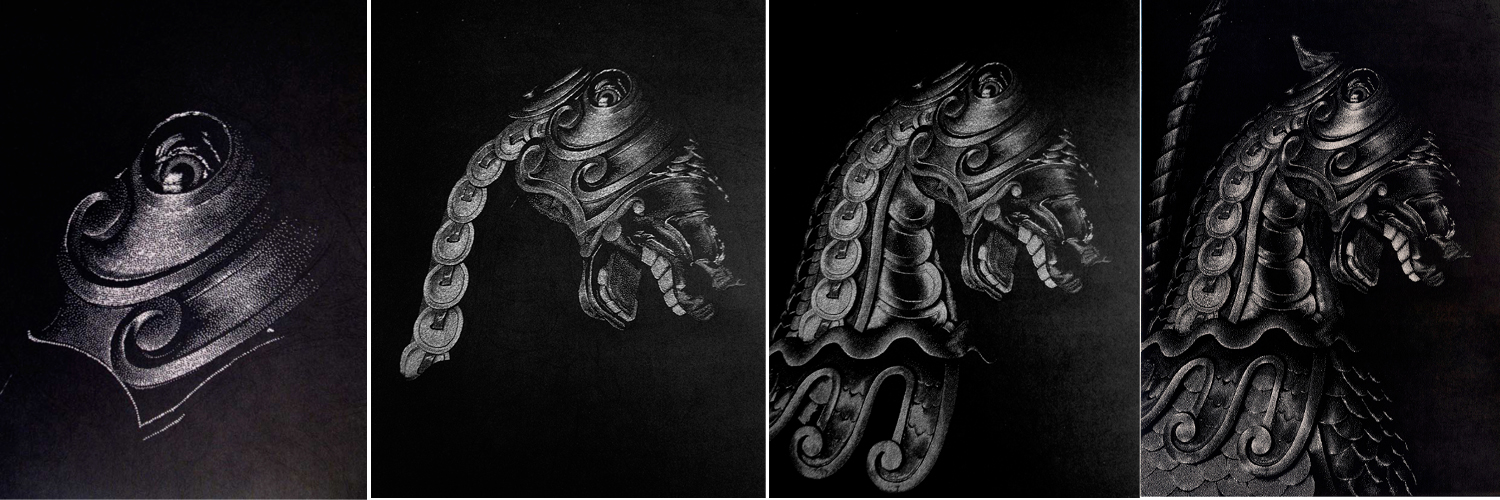
Making of the linoleum block for Carousel Horse in Armor (above), and the preliminary carousel drawing and the finished print (below).
What has been the response to your prints?
Mostly people say: “Whoa!” and “How did you do that?” The prints seem to surprise people.
I am happy to share that my linoleum cuts have been exhibited widely, have received enthusiastic attention in articles and reviews and were the source of an award grant in printmaking: the Bronx Council on the Arts BRIO Award for Printmaking in 2011.
Clay and Smoke I, print (L) and block (R)
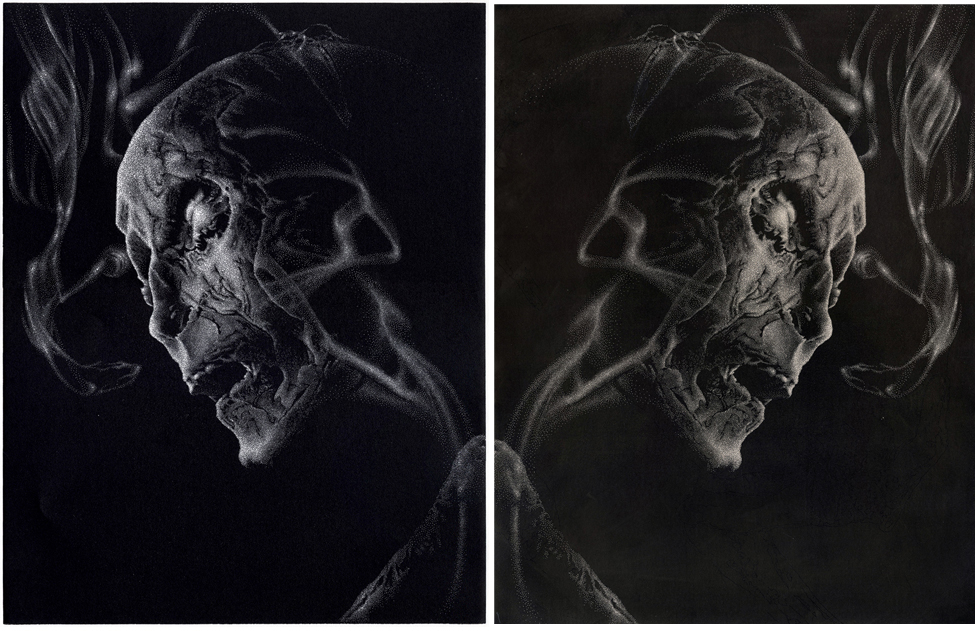 Clay and Smoke II, print (L) and block (R)
Clay and Smoke II, print (L) and block (R)
Trackback URL: https://www.scottponemone.com/donna-diamond-imaginingimaging-mortality-dot-by-dot/trackback/

